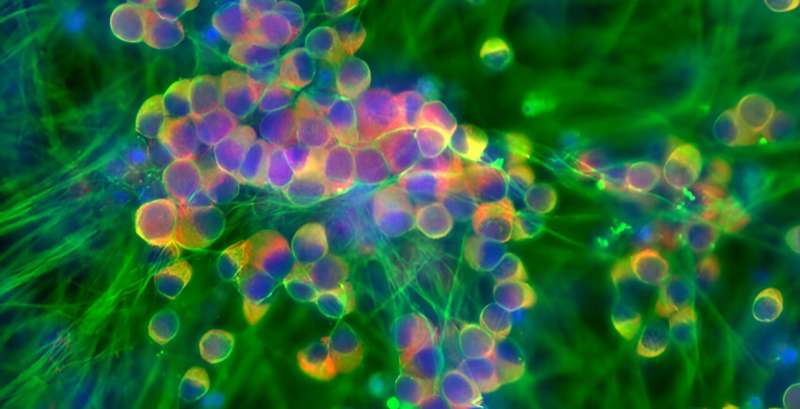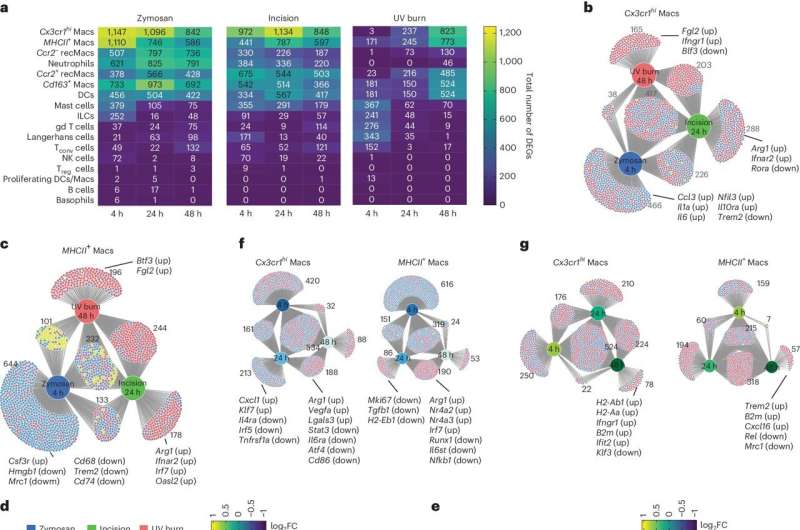This article has been reviewed according to Science X's editorial process and policies. Editors have highlighted the following attributes while ensuring the content's credibility:
fact-checked
peer-reviewed publication
trusted source
proofread
Neuroimmune interactions may help explain inflammatory pain, lead to better treatments

Researchers have just taken the most fine-grained look to date at inflammatory pain: increased sensitivity to pain that follows an immune response to a wound, infection, sunburn, arthritis, or other trigger.
In mouse and computer model experiments, the team identified thousands of molecular interactions—most not previously known—between pain-initiating neurons, or nociceptors, and different types of immune cells. These interactions could help explain why pain hypersensitivity sometimes occurs during inflammation—and could also help researchers resolve it.
Results are published in Nature Immunology.
The findings provide a platform to advance understanding of pain and find better treatments. Non-steroidal anti-inflammatory drugs (NSAIDs) such as ibuprofen are the current go-to for inflammatory pain, and while these medicines work fairly well, chronic use can cause side effects, and they aren't equally effective for all sources of pain.
Study senior author Clifford Woolf, Harvard Medical School professor of neurology and neurobiology and director of the F.M. Kirby Neurobiology Center at Boston Children's Hospital, has been trying to identify safer, more effective painkillers that don't involve opioids. The new study—led by first author Aakanksha Jain, HMS research fellow in neurology at Boston Children's, in collaboration with the HMS Laboratory of Systems Pharmacology as part of the STOP PAIN program—takes another step toward that goal.
Neuroimmune interactions
Jain and colleagues used single-cell RNA sequencing to explore the crosstalk between nociceptors and different types of immune cells in the skin when mice were exposed to three different types of pain triggers.
Each trigger produced extensive changes in gene expression in the different immune cell types, especially macrophages. Some changes happened right away while others took days to appear.
Next, using a database of neuroimmune interactions generated through a platform called INDRA, Jain and colleagues mapped out separate cellular "interactomes" for each injury type before, during, and after a pain episode.
Cell signaling went in both directions: Immune cells acted on nociceptors and vice versa.

"In the past, people looked at the nervous system's role in pain and the immune system's role in pain," said Woolf. "We're saying that's an artificial separation; the immune and nervous system work together. We have to embrace complexity."
The key finding was that inflammatory pain isn't a single entity. Each of the three inflammatory pain sources the researchers tested produced distinct networks of interactions between nociceptors and immune cells. That means all three have different mechanisms driving pain, said Jain.
Jain added that understanding the fundamentals of inflammatory pain provides a more solid foundation for finding ways to quell it.
"Now that we have the network of interactions, we can look for ways to promote resolution of pain," she said.
A new analgesic for inflammatory pain?
In addition to mechanisms driving pain, the study found that immune cells made and secreted more of a factor called thrombospondin1 (TSP1) in all three pain models. TSP1 had never been studied in pain or in the peripheral nervous system before, Jain said.
"We set out to identify immune molecules that drive pain, thinking we could block them, but TSP1 kept coming up," said Jain.
Treating nociceptors with TSP1 suppressed their pain signaling. The researchers think that TSP1 may help restore balance, easing pain when it's no longer needed as an alert system.
"We know there are endogenous opioids"—opioids made within the body—"but it was unexpected that there was something else with a pain-suppressive action," said Woolf.
The researchers plan further studies of TSP1 and the CD47 receptor it acts on to see if they can develop a pain treatment. They also plan to use their discovery platform to find new factors that cause or help resolve pain.
Woolf sees applications in treating pain from trauma and in managing pain after surgery. Ultimately, Jain hopes to go beyond the skin model used in this study to explore joint pain in rheumatoid arthritis and osteoarthritis.
More information: Aakanksha Jain et al, Nociceptor-immune interactomes reveal insult-specific immune signatures of pain, Nature Immunology (2024). DOI: 10.1038/s41590-024-01857-2



















